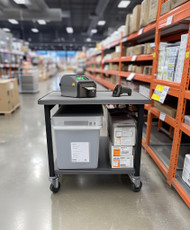The Unexpected Savings of Thermal Printing
Published by Becky Cramer on 15th Aug 2025
When a business is looking for a new printer, the initial price tag is often the first thing they consider. Inkjet printers are typically cheap to buy, making them seem like the most cost-effective option. However, this is where the misconception lies. While the upfront cost is low, the long-term expenses of inkjet printing, especially for high volume tasks, can quickly add up.
This article will explore why thermal printing, despite a potentially higher initial cost, offers significant and surprising cost savings that make it a smarter long-term investment.
The Hidden Cost of Inkjet Printers
Inkjet printers operate by spraying tiny droplets of liquid ink onto paper. While this process can produce high-quality, full-colour documents and photos, it comes with a major recurring cost: consumables. Ink cartridges are notoriously expensive and need to be replaced frequently. For a business that prints a high volume of receipts, labels, or barcodes, the cost of constantly buying new ink can become a major drain on resources.
Additionally, inkjet printers are more prone to maintenance issues. Ink nozzles can clog, requiring frequent cleaning cycles that waste even more ink. They also have more moving parts, which can lead to more frequent mechanical failures and repair costs.
Thermal Printing: The Case for Long-Term Savings
Thermal printing is a completely different technology that relies on heat to create an image, and it's this fundamental difference that leads to its significant cost benefits.
1. No Ink or Toner
This is the most impactful and immediate saving. Thermal printers operate without ink, toner, or ribbons (in the case of direct thermal printing). This eliminates the single largest recurring expense associated with printing. Over the lifespan of the printer, this can save a business thousands of dollars.
2. Reduced Maintenance
With no ink cartridges to clog or replace, thermal printers are incredibly simple machines. They have fewer moving parts, which means fewer opportunities for things to break down. This results in less downtime and lower repair costs. The primary maintenance is simply cleaning the printhead to ensure consistent, high-quality output.
3. Minimal Waste
Thermal printers use a continuous roll of paper or labels, so you print only what you need. This eliminates the waste of partially used sheets of labels or paper, a common problem with inkjet printers that use standard-sized sheets. This is particularly efficient for applications like printing individual shipping labels or barcodes on demand.
4. Speed and Efficiency
Thermal printers are significantly faster than inkjet printers, with the ability to print a label in a matter of seconds. This increased speed not only boosts productivity but also contributes to operational savings by allowing employees to move through tasks more quickly.
Conclusion: A Strategic Investment
While an inkjet printer may seem appealing due to its low initial price, it's a classic example of a purchase with high long-term costs. For any business that requires high-volume printing of labels, receipts, or barcodes, a thermal printer is a strategic investment that pays for itself over time. The cumulative savings on ink, maintenance, and waste make it the far more economical choice in the long run.
By choosing thermal printing, businesses can streamline their operations and reallocate the money they would have spent on ink cartridges to more productive areas.
